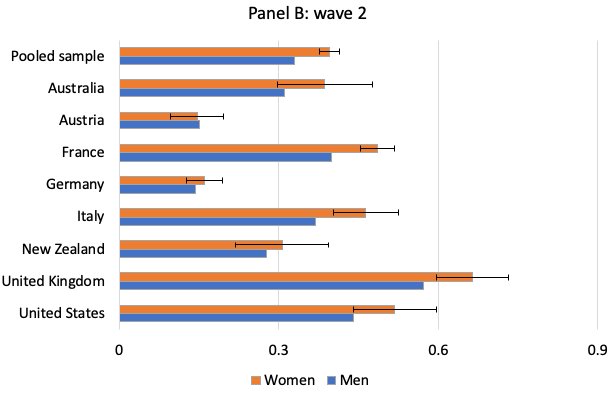A second wave of COVID-19 is currently hitting countries throughout the world, and putting their public health systems to the test. Many governments are struggling to contain the pandemic and some have already resolved to implement new lockdown measures.
The efficacy of these measures hinges on maximal compliance (Bargain and Aminjonov 2020). People’s willingness to comply with restrictive policies was uneven at the beginning of the pandemic and has steadily declined over time. To enhance policy effectiveness, it is critical to convince those who are the least compliant. But who exactly are these people?
To address this question, we conducted an original survey in eight OECD countries (Australia, Austria, France, Germany, Italy, New Zealand, the UK, and the US). We interviewed representative panels of a total of 21,649 respondents in two waves. The first wave was administered between 16 and 30 March 2020, soon after the pandemic reached the sample countries, and the second one between 15 and 20 April.
The surveys were centred on questions about individual beliefs and behaviours. Respondents were first asked how serious they expected the health consequences of COVID-19 to be, and whether they agreed with several public policy measures that were being debated or had already been implemented, including:
- closing schools
- closing non-essential businesses, economic activities, and institutions
- stopping public transportation
- prohibiting meetings of two or more people
- imposing quarantine on people entering the country
- closing borders
- mandating the use of face masks in public places.
Respondents were also asked to report their current level of compliance with several COVID-19-related health and social-distancing rules, such as wearing face masks, washing hands, coughing into one’s elbow, stopping hugging or greeting, keeping physical distance from others, staying at home, avoiding crowded places, and stopping meeting friends.
When analysing the answers, a striking difference emerges between men and women. As we show in our paper, gender differences are strong both in beliefs and in behaviours (Galasso et al. 2020).
First, women are more likely to take the pandemic seriously. In March, 59% of women respondents considered COVID-19 a very serious health problem, compared to 49% of men. In mid-April, both numbers decreased but the gender difference remained: 40% of women still saw the virus as a very serious risk, compared to 33% of men. This difference is present in all countries in the study.
Second, turning to behaviours, in the first wave, we considered compliance with washing hands more often, coughing into one’s elbow, not greeting people by shaking hands or hugging, avoiding crowded places, keeping physical distance from others, staying at home, and stopping visits to friends. In the second wave, we added three outcomes: wearing face masks in public places, wearing gloves in public places, and leaving home less than once a day. We construct an overall index of respondents’ compliance with these public-health and social-distancing rules in each wave by normalising responses on a 0 to 1 scale and averaging them out.
Figure 1 displays our compliance index separately for men and women by country in the first wave (Figure 1A) and the second wave (Figure 1B). The figure shows that women are more compliant than men in all countries and in both waves. Overall, 88% of women versus 83% of men followed the public-health recommendations in March, and 78% of women versus 72% of men in April. The gender gap in compliance increased slightly over time because the decrease in compliance with health measures was lower for women.
Figure 1 Compliance with public-health recommendations for men and women, by country, in March 2020 (Panel A) and in April 2020 (Panel B)
Along with differences in biology, pre-existing conditions, occupations, smoking, and propensity to seek healthcare, all of which have been emphasised in prior research, women’s more cautious behaviour may help explain why they are dying in much lower numbers than men in all countries. Furthermore, women’s higher compliance with rules such as wearing masks also implies that they are less likely to spread the disease than men, conditional on being infected.
Gender differences in beliefs and behaviours remain sizeable when we control for individual socio-demographic characteristics and psychological factors such as risk aversion, trust towards scientists, and the perceived likelihood to be infected, as well as political ideology. The differences are only partially mitigated for individuals cohabiting or with direct exposure to COVID-19.
The observed differences between the way men and women have adjusted to the new risks associated with COVID-19 are echoed in behavioural differences between male and female leaders. Countries led by women have generally responded more effectively to the pandemic than countries led by men (Garikipati and Kambhampati 2020).
In fact, in countries such as Denmark, Finland, Germany, Iceland, New Zealand, female leaders have utilised a more democratic and inclusive style with decisive and clear communication strategies. In contrast, some of the countries with the worst outcomes, including the US, Brazil, and the UK, are led by male leaders who have prioritised projection of strength and masculinity, often dismissing the need for precautionary practices.
All countries in the world are struggling to find the most effective policies to contain infection and reduce the spread of the COVID-19 pandemic. Restrictive measures such as wearing face masks have proved to be effective to reduce both the individual risk of infection and the likelihood of infecting others. Communication of and compliance with these rules are fundamental to ensure their effectiveness, decrease the likelihood of protracted lockdowns, and limit economic damages. To attain these objectives, public-health policies should target men and women differently in their communication.
References
Bargain, O and U Aminjonov (2020), “Trust and compliance with public health policies in the time of COVID-19”, VoxEU.org, 23 October.
Galasso, V, V Pons, P Profeta, M Becher, S Brouard and M Foucault (2020), “Gender differences in COVID-19 related attitudes and behavior: Evidence from a panel survey in eight OECD countries”, Proceedings of the National Academy of Sciences of the United States of America 117(44): 27285–91.
Garikipati, Z and U Kambhampati (2020), “Women leaders are better at fighting the pandemic”, VoxEU.org, 21 June.







